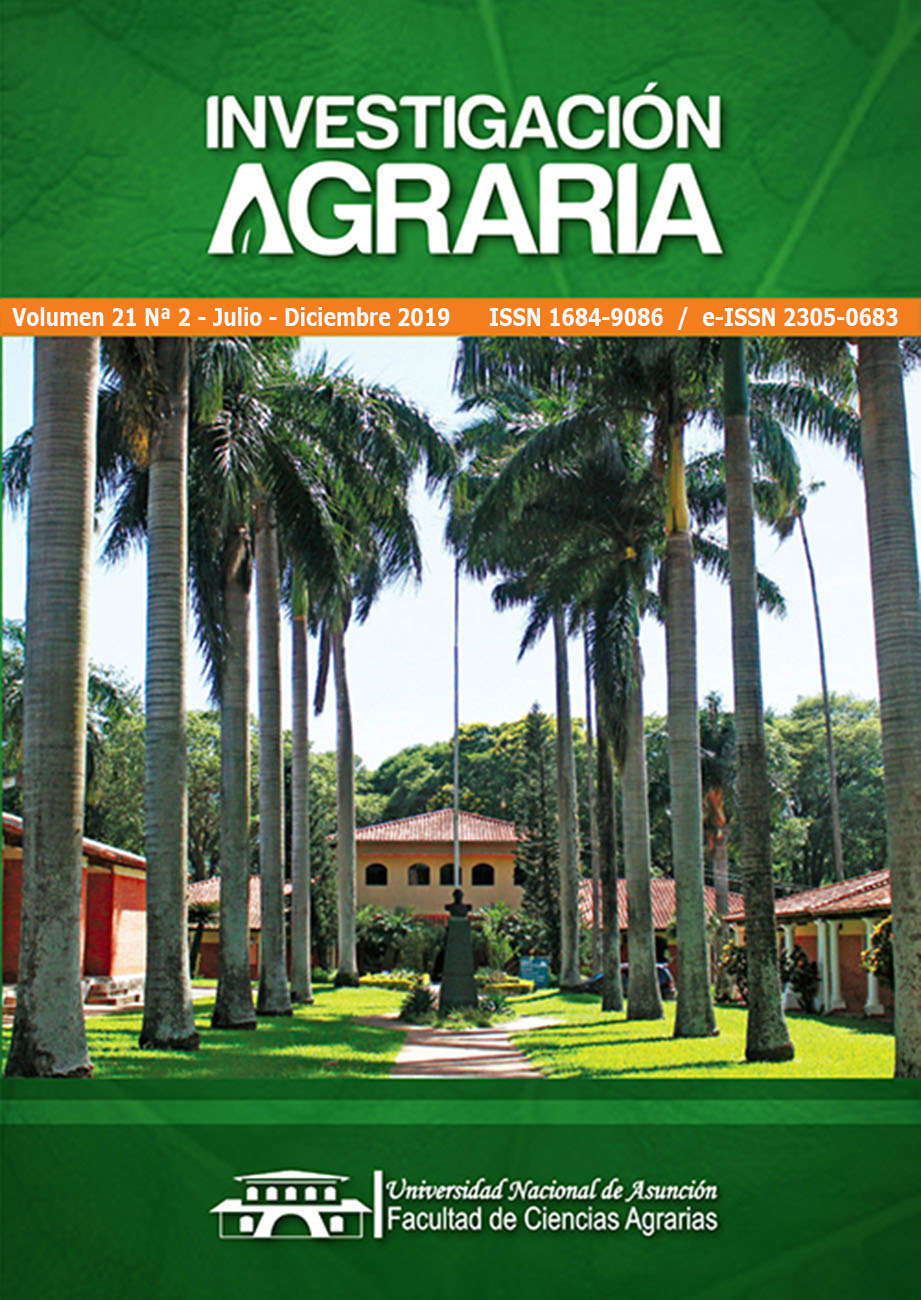Influence of levels of Tubixaba tuxaua infestation (Monteiro & Lordello, 1980) in the cultivation of soybean crop
DOI:
https://doi.org/10.18004/investig.agrar.2019.diciembre.142-148%20%20Abstract
Tubixaba tuxaua is a phytonematode that causes damage to crops and was recently identified in soil samples from Paraguay. Due to the scarcity of local information on the damage caused to soybean cultivation, a study was carried out with the objective of evaluating the effects on development and yield caused by different densities of Tubixaba tuxaua in the soybean crop. The experiment was carried out in field conditions, in the 2016/2017 cycle, in Tempiaporenda, Caazapá, Paraguay, in a plot with 10 years of soybean production. According to the symptoms observed 48 days after sowing, 3 areas of infestation were delimited and distributed in a completely randomized experimental design with 12, 6 and 7 repetitions, for the areas of high, medium and free infestation of Tubixaba tuxaua respectively. The variables analyzed were; population of the nematode, foliar area, dry mass, height of plant, number of pods, weight of 100 grains and yield. The results showed statistical differences between the treatments for all the variables except weight of 100 grains. It was observed that in areas with a greater population of nematodes, there was a decrease in plant height, number of pods, foliar area, dry mass and yield with a decreasing tendency.Downloads
Metrics
References
CAPECO (Cámara Paraguaya de Exportadores y Comercializadores de Cereales y Oleaginosas). (2016). Ranking mundial. Consultado 05 sep. de 2016. Disponible en http://capeco.org.py/ranking-mundial-es/
Carneiro, R.M.D.G. y Carneiro, R.G. (1983). Estudos preliminares sobre o nematoide Tubixaba tuxaua Monteiro & Lordello, 1980, na cultura do trigo no sudoeste do Paraná. Sociedade Brasileira de Nematologia, 7, 251-259.
Centurión, F., Shimizu, K. & Momota, Y. (2004). First record of soybean cyst nematode, Heterodera glycines Ichinohe from Paraguay. Nematological Research, 34, 39-42.
Centurión, F., Uehara, T., Kanno, T., Baigorri, H. y Shimizu, K. (2001). Nematodos parásitos em cultivos de soja y pasturas en Argentina, Brasil y Paraguay y su control. Nematologia Brasileira, 25 (Supl.): 107
Di Rienzo J.A., Casanoves, F., Balzarini, M.G. Gonzalez, L., Tablada, M. y Robledo, C.W. (2016). InfoStat versión 2016. Grupo InfoStat. Argentina : FCA, Universidad Nacional de Córdoba. Disponible en : http://www.infostat.com.ar
Dildey, O.D.F., Broetto, L., Müller, M.A., Mioranza, T.M., Coltro, S., Meinerz, C.C… Bonett, L.P. (2011). Influência de diferentes populações de Tubixaba tuxaua na altura de planta de soja (Glycine max (L.) Merril). Tropical Plant Pathology (BR), 36, 1215.
Dildey, O.D.F., Broetto, L., Müller, M.A., Mioranza, T.M., Coltro, S., Meinerz, C.C...Bonett, L.P. (2011ª). Influência de diferentes populações de Tubixaba tuxaua no número de vagens em soja (Glycine max (L.) Merril). Tropical Plant Pathology (BR), 36, 1217.
Easlon, H.M. & Bloom, A.J. (2014). Easy Leaf Area: Automated digital image analysis for rapid and accurate measurement of leaf area. Applications in plant sciences, 2(7), 1400033
Fehr, W.R., Caviness, C.E., Burmood, D.T. & Pennington, J.S. (1971). Stage of development descriptions for soybeans (Glycine max L.). Crop science, 11(6), 929-931
Furlanetto, C., Cares, J.E., Cruz, M.I.F. & Guimarães, R. (2012). Development of winter cover crops in soil infested with the nematode Tubixaba tuxaua in Western Paraná, Brazil. Rev. Nematropica. 42(2): 314-319.
Furlanetto, C., Davi, J.J.S., Grabowski, M.M.S., Dias-Arieira, C.R., Layter, N.A. & Seifert, K. (2008). Reação de adubos verdes de verão ao nematoide Tubixaba tuxaua. Tropical Plant Pathology (BR), 33 (6), 403-408.
Furlanetto, C., Seifert, K.E., Fensterseifer, C.E., Page, E.C., Davi, J.J.S. é Grabowski, M.M.S. (2010). Desenvolvimento das culturas de soja, milho e trigo cultivadas em áreas infestadas com o nematóide Tubixaba tuxaua no Oeste do Paraná. Rev. Tropical Plant Pathology ., 35(5), 295-302.
Kantolic, G., Giménez, P.I. y De La Fuente, E.B. (2003). Ecofisiología del cultivo de soja; bases para el manejo y para el aumento del rendimiento potencial. En: Reunión de Actualización en Soja Criadero Don Mario, 2 de junio 2003. Trabajos presentados. Buenos Aires: Facultad de Agronomía. Cátedra de Cultivos Industriales. Departamento de Producción Vegetal, 6 p.
Leiva, N.P.F., Severino, J.J. é Zabini, A.V. (2016). Ocorrência de fitonematoides na região oriental do Paraguai. Em : 33° Congresso Brasileiro de Nematologia. 12 a 17 de junio de 2016. Petrolina, Brasil : EMBRAPA
McCarter, J.P. (2009). Molecular approaches toward resistance to plant-parasitic nematodes. In: Berg, R.H., Taylor, C. Cell Biology of Plant Nematode Parasitism. Springer: Berlin Heidelberg, 239-267.
Monteiro, A.R. & Lordello, L.G.E. (1980). Tubixaba tuxaua n.gen. n.sp. A suspected parasitic nematode of soybean roots (Aporcelaimidae). Rev. de Agricultura, 55(4), 301-304.
Niblack, T.L. (2005). Soybean cyst nematode management reconsidered. Plant disease, 89(10), 1020-1026.
Niblack, T.L. (2009). Nematode. In. Illinois Agronomy Handbook, 24th Edition: University of Illinois at Urbana-Champaign, College of Agriculture, Cooperative Extension Service, USA, 209- 218.
Roese, A.D., Romani, R.D., Furlanetto, C. , Stangarlin, J.R. é Portz, R.L. (2001). Levantamento de doenças na cultura da soja em municípios da região oeste do estado do Paraná. Acta Scientiarum (BR), 23, 1293-1297.
Sikora, R.A., Bridge, J. & Starr, JL. (2005). Management Practices: an Overview of Integrated Nematode Management Technologies. In: Luc, M., Sikora, RA., Bridge, J. Plant Parasitic Nematodes in Subtropical and Tropical Agriculture. 2 ed : CAB International, Wallingford, UK, 793-825.
Tihohod, D. (1993). Nematología Agrícola Aplicada. Jaboticabal : FUNEP, pp. 372.
Vovlas, N., Lamberti, F., Antonio, H., Monteiro, A.R. & Sharma, R.D. (1987). Morphological characteristics of Tubixaba tuxaua Monteiro & Lordello (Nematoda: Aporcelamidae). Rev. Nematologia Brasileira , 11, 293-299.
Downloads
Published
How to Cite
Issue
Section
License

This work is licensed under a Creative Commons Attribution 4.0 International License.
All content in this journal is under Creative Commons Attribution License.









 All content in this journal is under
All content in this journal is under 